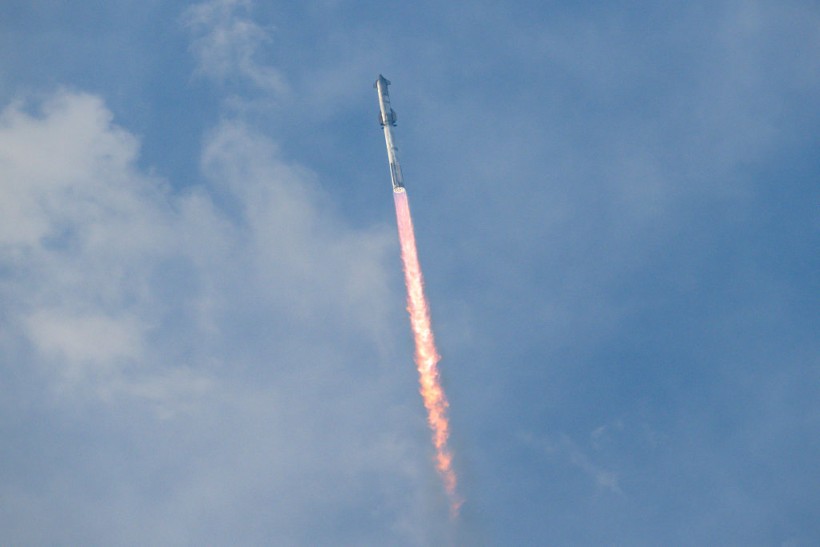SpaceX's monumental achievement unfolded as its Starship rocket reached orbital velocity for the first time, marking a significant stride towards in-space refueling capabilities.
However, the company faced a setback as the spacecraft was lost upon re-entry into the Earth's atmosphere over the Indian Ocean during its third test flight on Thursday, March 14. Despite this loss, no injuries or property damages have been reported thus far.

(Photo : CHANDAN KHANNA/AFP via Getty Images)
Starship's Third Test Flight: Triumphs and Setbacks in the Pursuit of Space Exploration
At approximately 8:25 a.m. CT, Starship, a nearly 400-foot-tall super-heavy-lift rocket and spacecraft, launched from SpaceX's private launchpad in South Texas. This marked its third test flight, demonstrating significant hardware improvements since its previous November launch. The launch from SpaceX's Starbase in Boca Chica, Texas, was broadcast live on a webcast platform, attracting millions of viewers on social media.
During the flight test conducted on March 14, known as Pi Day for mathematics enthusiasts, flight controllers supervised the transfer of several tons of liquid oxygen between tanks within Starship. This demonstration served as an initial trial for in-space fuel transfers, with SpaceX representatives indicating that further analysis of flight data is required to ascertain the success of the operation.
As the spacecraft approached its intended splashdown site in the Indian Ocean, communication with Starship was abruptly lost, marking the end of the mission.
Simultaneously, the first-stage booster fragmented, disintegrating earlier than anticipated over the Gulf of Mexico following its launch from the southern tip of Texas near the Mexican border. SpaceX's Dan Huot confirmed the loss, acknowledging the progress made despite the setback.
Starship attained an altitude of approximately 145 miles as it traversed the Atlantic and South Africa before its final approach to the Indian Ocean. However, contact was severed 49 minutes into the flight, leaving just 15 minutes remaining, with the spacecraft presumably breaking apart at an altitude of 40 miles while hurtling at speeds around 16,000 mph.
Elon Musk, SpaceX's founder, had lauded his team's efforts moments earlier, acknowledging the company's significant advancements since its inception 22 years prior. Despite the challenges encountered during the mission, the flight showcased the remarkable progress and dedication of SpaceX in pushing the boundaries of space exploration.
READ ALSO: SpaceX Targets Mid-March for Starship Test Launch, Aiming for Martian Colonization
SpaceX's Starship Journey Towards Deep Space Exploration
Starship's third test launch in its fully stacked configuration marked a significant milestone for SpaceX, as the company aimed to achieve various objectives. Despite previous setbacks, such as the destruction of Starship during an integrated test in April 2023 and a partial success with a subsequent test in November 2023, SpaceX pressed forward with its ambitious goals.
During the third test, Starship demonstrated impressive capabilities, reaching speeds exceeding 26,000 kilometers per hour and soaring to altitudes surpassing 200 kilometers above sea level. High-definition footage captured the spacecraft's graceful traversal through space, showcasing its potential for future missions.
With each test flight, SpaceX faces the dual challenge of refining Starship's capabilities while meeting stringent timelines for future missions. The company's strategy of real-world testing has proven successful in the past, with its Falcon 9 rockets becoming vital assets for NASA and the commercial sector.
As SpaceX prepares for NASA's planned return to the moon in 2026 and contends with competition from China's lunar exploration program, the pressure mounts to demonstrate Starship's ability to safely launch, fly, and land while also proving its capacity for in-orbit refueling-a crucial step for future deep-space missions.
READ ALSO: FAA Authorizes SpaceX's Starship Rocket Test Flight from Texas, Potential Pre-Sunrise Launch
Check out more news and information on SpaceX in Science Times.



![Earth's Quasi-Moon Kamo‘oalewa Could Originate From Lunar Surface Not Asteroid Belt [Study]](https://1721181113.rsc.cdn77.org/data/thumbs/full/53275/89/56/50/40/earths-quasi-moon-kamo-oalewa-could-originate-from-lunar-surface-not-asteroid-belt-study.png)










